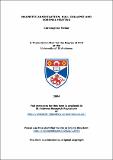Files in this item
Magnetic annihilation, null collapse and coronal heating
Item metadata
| dc.contributor.advisor | Priest, E. R. (Eric Ronald) | |
| dc.contributor.author | Mellor, Christopher | |
| dc.coverage.spatial | ix, 114 p. | en_US |
| dc.date.accessioned | 2018-03-15T11:10:14Z | |
| dc.date.available | 2018-03-15T11:10:14Z | |
| dc.date.issued | 2004 | |
| dc.identifier.uri | https://hdl.handle.net/10023/12946 | |
| dc.description.abstract | The problem of how the Sun's corona is heated is of central importance to solar physics research. In this thesis we model three main areas. The first, annihilation, is a feature of non-ideal MHD and focusses on how magnetic field of opposite polarity meets at a null point and annihilates, after having been advected with plasma toward a stagnation point in the plasma flow. Generally, the null point of the field and the stagnation point of the flow are coincident at the origin, but in chapter 2 a simple extension is considered where an asymmetry in the boundary conditions of the field moves the null point away from the origin. Chapter 3 presents a model of reconnective annihilation in three dimensions. It represents flux being advected through the fan plane of a 3D null, and diffusing through a thin diffusion region before being annihilated at the spine line, and uses the method of matched asymptotic expansions to find the solution for small values of the resistivity. The second area of the thesis covers null collapse. This is when the magnetic field in close proximity to a null point is disturbed, causing the field to fold up on itself and collapse. This is a feature of ideal MHD, and causes a strong current to build up, allowing non-ideal effects to become important. When using linearised equations for the collapse problem, we are in fact looking at a linear instability. If this instability initiates a collapse, this is only a valid model until non-linear effects become important. By talking about collapse in chapters 4 and 5 (as it is talked about in the literature), we mean that the linear instability initiates collapse, which in principle, non-linear effects could later stop. Chapter 4 introduces a two-dimensional model for collapse, using the ideal, compressible, linearised MHD equations. It is a general solution in which all spatially linear nulls and their supporting plasma flows and pressure gradients can be checked for susceptibility to collapse under open boundary conditions. Chapter 5 uses the model introduced in chapter 4 to investigate the collapse of three-dimensional, potential nulls (again, spatially linear) for all possible supporting plasma flows and pressure gradients. Using this model, all nulls under consideration are found to collapse and produce large currents, except for a group of 2D O-type nulls supported by highly super-Alfvenic plasma flows. The third area of this thesis involves numerically simulating a model of heating by coronal tectonics (Priest et al, 2002). A simple magnetic field is created and the boundary is driven, also in a simple manner. Current sheets which scale with grid resolution are seen to build up on the quasi-separatrix layers, and there is some evidence of magnetic reconnection. | en_US |
| dc.language.iso | en | en_US |
| dc.publisher | University of St Andrews | en |
| dc.subject.lcc | QB529.M4 | |
| dc.subject.lcsh | Magnetohydrodynamics. | en |
| dc.subject.lcsh | Solar magnetic fields. | en |
| dc.subject.lcsh | Sun--Corona. | en |
| dc.subject.lcsh | Plasma (Ionized gases) | en |
| dc.title | Magnetic annihilation, null collapse and coronal heating | en_US |
| dc.type | Thesis | en_US |
| dc.type.qualificationlevel | Doctoral | en_US |
| dc.type.qualificationname | PhD Doctor of Philosophy | en_US |
| dc.publisher.institution | The University of St Andrews | en_US |
This item appears in the following Collection(s)
Items in the St Andrews Research Repository are protected by copyright, with all rights reserved, unless otherwise indicated.

